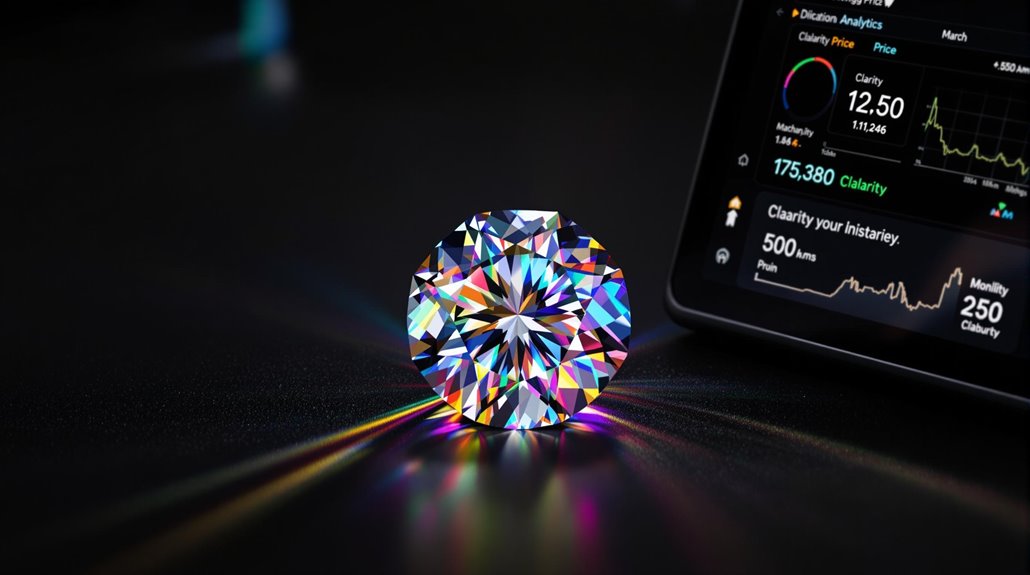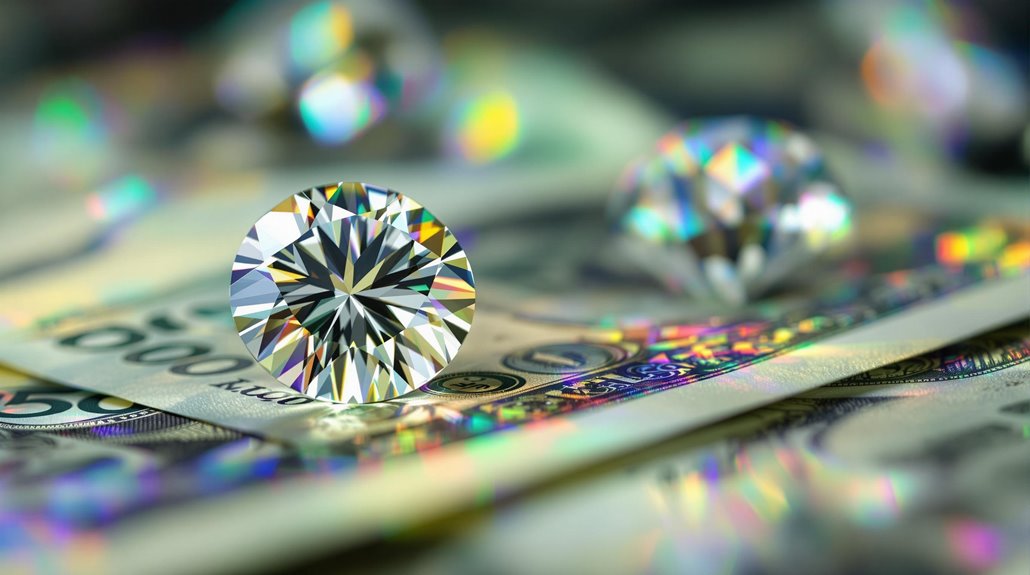Article Contents
- 1 Main Highlights
- 2 Understanding Diamond Market Fundamentals
- 3 Lab-Grown Vs Natural Investment Options
- 4 Emerging Markets and Growth Opportunities
- 5 Sustainability in Diamond Investments
- 6 Technology Impact on Diamond Values
- 7 Portfolio Building Through Diamond Assets
- 8 Frequently Asked Questions
- 8.1 How Do Geopolitical Tensions Affect Diamond Pricing in Different Global Regions?
- 8.2 What Insurance Options Are Recommended for Significant Diamond Investment Portfolios?
- 8.3 Can Inheritance Tax Regulations Affect Diamond Investment Strategy Planning?
- 8.4 How Do Seasonal Market Fluctuations Influence Optimal Diamond Buying Timing?
- 8.5 What Documentation Should Investors Keep for Diamond Authentication and Resale Value?
- 9 Our Final Thoughts
The modern diamond investment environment offers two distinct paths: traditional natural stones and emerging lab-grown diamonds. Natural diamonds retain 25-50% of their value and symbolise timeless luxury. However, lab-grown substitutes cost 60-70% less and align with eco-conscious values, using significantly less water and producing fewer carbon emissions.
Your smartest investment strategy might combine both, balancing the enduring value of natural stones with the sustainable innovation of lab-grown diamonds. When building your portfolio, consider factors like certification, market trends, and technological authentication tools. The sparkling world of diamond investing holds deeper riches waiting to be discovered.
Main Highlights
- Consider lab-grown diamonds for maximum value, offering similar quality at 30-40% lower cost whilst maintaining ethical and sustainable standards.
- Diversify investment across both natural and lab-grown diamonds, keeping one-third of your portfolio in tangible diamond assets.
- Focus on diamonds with excellent colour grades and clarity levels, verified through digital authentication systems and blockchain technology.
- Monitor real-time market values using platforms like RapNet and StoneAlgo to make informed purchasing decisions.
- Invest in emerging markets like India and China, where growing demand is reshaping consumer behaviour and driving market growth.
Understanding Diamond Market Fundamentals
Diamonds, often considered the ultimate symbol of luxury, operate in a complex market driven by global supply and demand dynamics.
Like streams of light dancing through crystal, your understanding of these fundamentals will illuminate your investment path. The current diamond supply landscape is shifting, with production from strongholds like Russia, Botswana, and Canada shaping market availability. Lab-grown alternatives are rapidly gaining market share as technology advances and consumer acceptance grows. Natural diamond formation takes billions of years deep within Earth’s mantle under extreme conditions, contributing to their inherent value.
You’ll find that consumer trends ebb and flow with economic tides, particularly in key markets like the USA where confidence levels direct purchasing decisions. The durability of diamonds makes them a reliable long-term investment option.
The market’s projected growth to $155.5 billion by 2032 speaks to diamonds’ enduring charm, yet you must manoeuvre carefully.
With natural diamond supply expected to tighten by 1% annually, you’re looking at an environment where scarcity could become your ally in building long-term value.
Lab-Grown Vs Natural Investment Options
When you’re weighing up your diamond investment options, you’ll find that lab-grown diamonds offer a compelling price point at roughly one-quarter the cost per carat of their natural counterparts, like stars that shine just as brightly but cost less to capture. Visual testing experts cannot distinguish between the two types without specialised equipment.
The market’s crystal-clear path shows lab-grown diamonds gaining momentum, with projections indicating a 15-20% annual growth rate through 2025, although natural diamond supplies continue their gradual decline. The industry is expected to reach $14.9 billion in market value by 2030.
Yet beneath these shimmering statistics lies a significant consideration: natural diamonds historically retain about half their value, whereas lab-grown stones, despite their identical chemical composition, currently struggle to maintain their worth in the resale market.
Value Per Carat Comparison
A clear distinction emerges in the value-per-carat between lab-grown and natural diamonds, with synthetic stones priced 30-40% lower than their mined counterparts.
When you’re navigating the diamond market, you’ll find lab-grown jewels ranging from $800 to $8,000 per carat, while natural diamonds command $3,000 to $20,000+ per carat—a price comparison that reflects nature’s scarcity versus human innovation.
Your consumer preferences might lead you towards the financially prudent path of lab-grown diamonds, which often surpass 97% of mined stones in quality, like stars born of human ingenuity rather than the earth’s depths. Digital marketplaces have made diamond trading more accessible, transforming how investors approach both natural and lab-grown options.
Yet, consider that natural diamonds hold their value like ancient artefacts, retaining 25-50% of their original price, as lab-grown stones, though initially more affordable, may sparkle more in your heart than in your investment portfolio. With consumer awareness rising, from just 9% in 2010 to over 51% in 2018, the market landscape continues to evolve rapidly.
Market Growth Forecasts 2025
Looking ahead to 2025, you’ll see a stark contrast in growth trajectories between natural and lab-grown diamond markets. The sparkling performance of figures reveals an intriguing tale: as natural diamonds maintain a steady 3.70% CAGR, lab-grown diamonds are surging ahead at 15-20% annually, painting a fascinating picture of industry trends. The overall diamond market continues to expand, with online sales growth becoming particularly significant as e-commerce penetration reaches new heights in the luxury segment. Notably, 45% of brides now prefer lab-grown diamonds for their engagement rings, demonstrating a clear shift in consumer preferences.
| Market Aspect | Natural Diamonds | Lab-Grown Diamonds |
|---|---|---|
| 2025 Projections | $68.26B | $41.84B |
| Growth Rate | 3.70% CAGR | 15-20% Annual |
| Investment Appeal | High Resale Value | Cost Efficiency |
You’re witnessing a significant moment in diamond investing, where tradition meets innovation. Although natural diamonds’ steady growth reflects their enduring attraction, lab-grown diamonds’ explosive expansion signals a revolution in how we’ll think about diamond investments by 2025.
Emerging Markets and Growth Opportunities
Despite the historical dominance of established diamond markets, emerging economies such as India and China have become significant drivers of global diamond investment growth.
As emerging trends reshape the environment, you’ll discover unparalleled opportunities blossoming like desert flowers after rain, yet investment risks necessitate meticulous navigation through these uncharted waters.
Major industry players like De Beers and Alrosa continue to influence production levels and market dynamics in these regions.
The market is projected to expand significantly, reaching a value of USD 146.5 billion by 2033.
Consider these key factors when exploring emerging markets:
- Rising middle-class wealth is transforming consumer behaviour, particularly in Asian economies.
- Digital platforms are democratising access to diamond investments.
- Long-term growth potential exceeds that of traditional markets, especially in luxury segments.
You’re witnessing a pivotal shift in global diamond dynamics, where technological innovation meets traditional value.
The expanding e-commerce environment allows you to participate in this glittering transformation from anywhere, as emerging market consumers increasingly view diamonds as both personal gems and investment vehicles.
Sustainability in Diamond Investments
Sustainable diamond investments represent a groundbreaking shift in the industry, balancing profitability with environmental responsibility. When you’re choosing where to place your investment pounds, comprehension of the stark contrast between traditional mining and eco-friendly practices becomes essential. Lab-created diamonds shine not just in their brilliance, but in their commitment to ethical sourcing and environmental stewardship. Modern foundries utilise renewable energy sources to power their diamond production facilities, setting new standards for environmental responsibility. Traditional diamond extraction requires moving vast earth, with each carat demanding approximately 250 tonnes of displaced soil.
| Aspect | Traditional Mining | Lab Created |
|---|---|---|
| CO2 Emissions | 143 lbs/carat | 26 lbs/carat |
| Water Usage | 126 gal/carat | 18 gal/carat |
| Land Impact | High disruption | Minimal |
| Local Communities | Mixed impact | Positive growth |
You’ll find that investing in sustainable diamonds isn’t just about preserving Earth’s gems; it’s about crafting a legacy where conscience meets commerce, where each sparkle reflects a commitment to our planet’s future.
Technology Impact on Diamond Values

The terrain of diamond investing has been transformed by digital authentication systems that verify a stone’s identity with crystalline precision, much like a fingerprint carved in light.
Through advanced AI platforms, dealers can now manage vast inventories and update pricing instantly across global markets.
Modern market tracking tools now illuminate every facet of diamond pricing, offering you real-time data streams that pulse with the market’s heartbeat.
These technological advances have crafted a fabric of transparency and trust, allowing you to traverse the investment waters with unmatched clarity and confidence.
The integration of AI clarity grading has revolutionised how diamonds are evaluated, combining human expertise with machine precision for superior accuracy.
Digital Authentication Evolution
Modern technological advancements have transformed how the diamond industry authenticates and tracks its precious stones, with blockchain technology leading the charge. Through sophisticated digital ledger systems, you’re now empowered to trace your diamond’s path from mine to market, guaranteeing its authenticity with unparalleled clarity.
Today’s authentication methods have redefined how you can verify your diamond’s legitimacy:
- De Beers’ Tracr platform creates an unbreakable digital fingerprint
- The Kimberley Process certification guarantees conflict-free origins
- Multi-factor authentication systems protect your investment details
Like starlight captured in crystal, your diamond’s digital identity now shines through layers of blockchain verification, offering you the freedom to invest with confidence as you support ethical trading practices. Similar to how Strong Customer Authentication revolutionised digital banking security, these verification systems ensure maximum protection of your valuable assets.
This transparency illuminates not just your diamond’s beauty, but its entire history. With experts estimating that blood diamonds comprise 15% of the global trade, these verification systems are more crucial than ever.
Market Price Tracking Tools
Even though diamonds have always captivated investors, today’s digital tracking tools have transformed how you monitor their market values. With platforms like RapNet and StoneAlgo, you’ll experience extraordinary price transparency whilst navigating market volatility with confidence. These sophisticated tools illuminate the path to smarter diamond investments, much like a beacon in the complex world of precious stones. Industry professionals rely on weekly market updates from the Rapaport Price List to maintain competitive pricing strategies. The surge in diamond-focused investment has seen unprecedented auction prices in recent years.
| Platform Features | Benefits |
|---|---|
| Real-Time Data | Instant market observations |
| Historical Charts | Mastery of trend analysis |
| AI Predictions | Strategic advantage |
Diamond lovers are now empowered to track over 1.6 million diamonds through customisable searches and interactive price simulators. These tools not only offer data, but also empower you to make informed decisions by converting raw numbers into clear investment opportunities. Through blockchain technology, you’ll additionally guarantee your investments remain ethically sourced, adding both moral and monetary value to your portfolio.
Portfolio Building Through Diamond Assets
Building a robust diamond portfolio requires careful consideration of multiple investment vehicles and strategies.
Like rays of light dancing through a perfectly cut jewel, your investment approach should reflect both brilliance and precision, focusing on diamond rarity and investment diversification to maximise potential returns.
To create a well-balanced portfolio, consider these fundamental steps:
- Allocate your investments across different diamond types, including both natural and lab-grown specimens.
- Balance your holdings between loose stones and mounted jewellery pieces.
- Diversify across various colour grades and clarity levels.
You’ll want to maintain a dynamic mix of assets, keeping roughly one-third of your portfolio in tangible diamond investments. Private banking clients can leverage expert valuation services for accurate portfolio assessment.
This strategy helps protect your wealth against market volatility as you provide the freedom to adjust your holdings as market conditions evolve.
Regular appraisals and documentation of your collection will ensure you maintain accurate valuations for insurance and future transactions.
Frequently Asked Questions
How Do Geopolitical Tensions Affect Diamond Pricing in Different Global Regions?
You’ll see diamond supply disruptions and market volatility affecting prices differently across regions, with stronger currencies providing better purchasing capability during sanctions and trade restrictions creating regional price disparities.
What Insurance Options Are Recommended for Significant Diamond Investment Portfolios?
Like a fortress shields its valuables, you’ll need extensive investment protection through Jewellers Block insurance, credit coverage, and specialised portfolio policies that safeguard your diamond investments across global markets.
Can Inheritance Tax Regulations Affect Diamond Investment Strategy Planning?
You’ll need to factor inheritance planning into your diamond investment strategy, as tax implications can significantly affect wealth transfer to heirs. Consider trusts and strategic timing to protect your assets.
How Do Seasonal Market Fluctuations Influence Optimal Diamond Buying Timing?
You’ll find better deals during off-peak seasons like July-August and September-October. Monitor seasonal trends carefully and plan your purchasing strategy around quieter periods, avoiding major holidays for maximum savings.
What Documentation Should Investors Keep for Diamond Authentication and Resale Value?
Keep your diamond certificates from reputable labs and current valuation reports, along with blockchain authentication records and provenance documentation. You’ll need these to prove authenticity and maximise resale potential.
Our Final Thoughts
Just as a master jeweller knows precisely where to place each cut to release a diamond’s fire, you’ll need to strategically position your investment choices to maximise returns. In today’s market, where a single one-carat natural diamond can appreciate by 15% annually, your portfolio’s brilliance depends on balancing traditional assets with emerging opportunities. Let technology illuminate your path as sustainability shapes your legacy in this crystalline frontier of wealth building.

